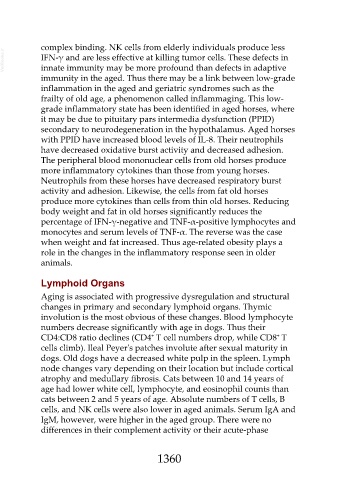Page 1360 - Veterinary Immunology, 10th Edition
P. 1360
complex binding. NK cells from elderly individuals produce less
VetBooks.ir IFN-γ and are less effective at killing tumor cells. These defects in
innate immunity may be more profound than defects in adaptive
immunity in the aged. Thus there may be a link between low-grade
inflammation in the aged and geriatric syndromes such as the
frailty of old age, a phenomenon called inflammaging. This low-
grade inflammatory state has been identified in aged horses, where
it may be due to pituitary pars intermedia dysfunction (PPID)
secondary to neurodegeneration in the hypothalamus. Aged horses
with PPID have increased blood levels of IL-8. Their neutrophils
have decreased oxidative burst activity and decreased adhesion.
The peripheral blood mononuclear cells from old horses produce
more inflammatory cytokines than those from young horses.
Neutrophils from these horses have decreased respiratory burst
activity and adhesion. Likewise, the cells from fat old horses
produce more cytokines than cells from thin old horses. Reducing
body weight and fat in old horses significantly reduces the
percentage of IFN-γ-negative and TNF-α-positive lymphocytes and
monocytes and serum levels of TNF-α. The reverse was the case
when weight and fat increased. Thus age-related obesity plays a
role in the changes in the inflammatory response seen in older
animals.
Lymphoid Organs
Aging is associated with progressive dysregulation and structural
changes in primary and secondary lymphoid organs. Thymic
involution is the most obvious of these changes. Blood lymphocyte
numbers decrease significantly with age in dogs. Thus their
+
+
CD4:CD8 ratio declines (CD4 T cell numbers drop, while CD8 T
cells climb). Ileal Peyer's patches involute after sexual maturity in
dogs. Old dogs have a decreased white pulp in the spleen. Lymph
node changes vary depending on their location but include cortical
atrophy and medullary fibrosis. Cats between 10 and 14 years of
age had lower white cell, lymphocyte, and eosinophil counts than
cats between 2 and 5 years of age. Absolute numbers of T cells, B
cells, and NK cells were also lower in aged animals. Serum IgA and
IgM, however, were higher in the aged group. There were no
differences in their complement activity or their acute-phase
1360

